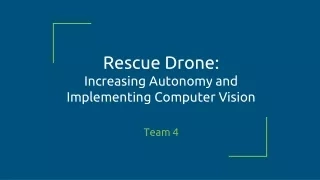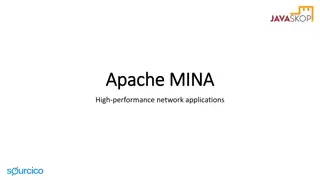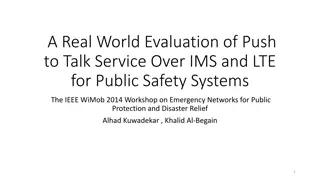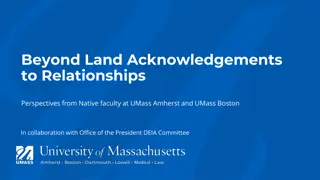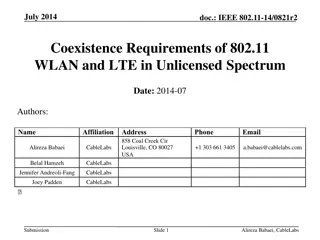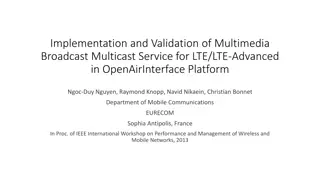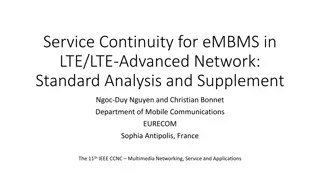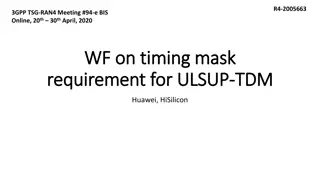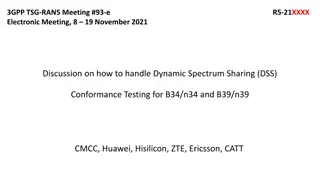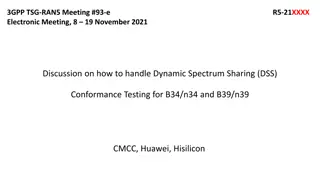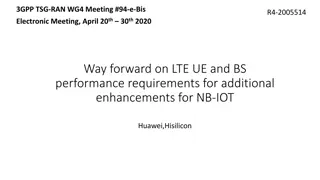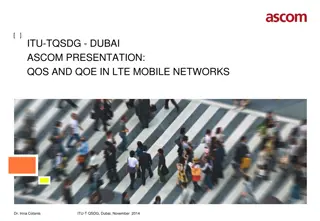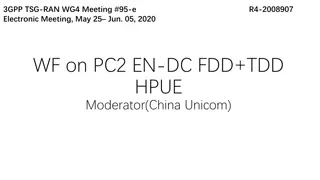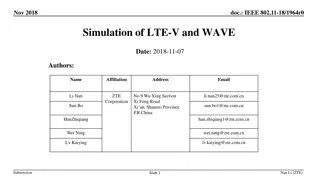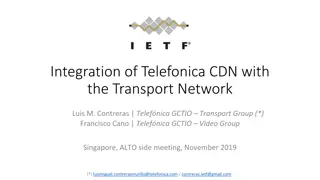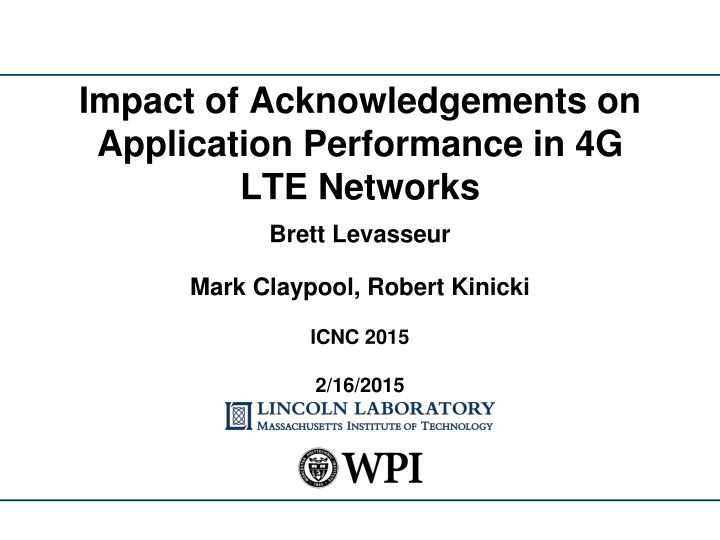
Impact of Acknowledgements on LTE Network Performance
This study explores the impact of acknowledgements on application performance in 4G LTE networks, examining retransmission policies and configurations. It delves into the growth of mobile networks worldwide, LTE retransmission mechanisms, and network simulators like ns-3.
Download Presentation

Please find below an Image/Link to download the presentation.
The content on the website is provided AS IS for your information and personal use only. It may not be sold, licensed, or shared on other websites without obtaining consent from the author. If you encounter any issues during the download, it is possible that the publisher has removed the file from their server.
You are allowed to download the files provided on this website for personal or commercial use, subject to the condition that they are used lawfully. All files are the property of their respective owners.
The content on the website is provided AS IS for your information and personal use only. It may not be sold, licensed, or shared on other websites without obtaining consent from the author.
E N D
Presentation Transcript
Impact of Acknowledgements on Application Performance in 4G LTE Networks Brett Levasseur Mark Claypool, Robert Kinicki ICNC 2015 2/16/2015
Network Growth Worldwide Mobile networks in 2013 billion mobile devices added 77% of this growth from smartphones Mobile data traffic grew 81% Mobile video traffic 51% of all mobile data 4G in 2013 2.9% of all connections Account for 30% of all mobile traffic Predicted to be of all connections in 2018 [Cisco 13] ICNC 15 - 2 BML 11/14/14
General Problem Statement LTE responds to poor signal quality by decreasing throughput LTE has multiple configuration parameters for wireless retransmissions How do LTE retransmissions impact application performance? What LTE retransmissions settings impact application performance? Which LTE retransmission policies are preferred in different wireless loss conditions? ICNC 15 - 3 BML 11/14/14
Outline Introduction Background Approach Results Conclusion ICNC 15 - 4 BML 11/14/14
LTE Retransmissions: MAC [Dahlman 11] 1ms TTI Hybrid Automatic Request Reply (HARQ) Data sent at time n, arrives at time n 3ms taken to check if data arrived with errors n+4 ACK/NACK sent back n+8 if NACK, data can be retransmitted Up to 3 retransmissions for downlink traffic ICNC 15 - 5 BML 11/14/14
LTE Retransmissions: RLC Unacknowledged Mode No retransmissions Timer t-Reordering wait before handing data up a layer for MAC layer to try recovery Acknowledged Mode Retransmissions Timer t-Reordering wait before requesting retransmission Timer t-StatusProhibit wait before sending RLC ACK/NACK message ICNC 15 - 6 BML 11/14/14
ns-3 Open source packet level network simulator Successor to ns-2 Funded by National Science Foundation and the Planete group at INRIA Sophia Antipolis 2009 - 2012 ns-3 downloaded 50,792 times LTE/EPC Network Simulator (LENA) Developed Centre Tecnologic de Telecomunicacions de Catalunya [ns-3] [ns-3 stats] [Baldo 11] ICNC 15 - 7 BML 11/14/14
Related Work Applications used in mobile networks B hmer et al. Mobile apps mostly used for communication Huang et al. Majority of data over LTE uses TCP HARQ Kawser et al. Found that MAC retransmissions could be limited to 3 or less as allowing more in poor signal quality conditions did not improve reception RLC AM Makidis Examined TCP with RLC AM for VoIP and FTP but did not examine UM or MAC layer retransmissions ICNC 15 - 8 BML 11/14/14
Outline Introduction Background Approach Results Conclusion ICNC 15 - 9 BML 11/14/14
Specific Problem Statement How do MAC and RLC layer retransmission impact VoIP, FTP, Video Delay/Loss/Throughput sensitive How does adjusting RLC timer settings impact retransmissions and application performance When is it better to use RLC AM or UM with varying loss rates at physical layer ICNC 15 - 10 BML 11/14/14
ns-3 LTE Modifications LTE module for ns-3 did not support NACKs in AM STATUS message Joined discussion forum to implement NACKs Worked with LTE module developers and others Provided code for (de-)serializing NACKs to developers Discussed specifics of AM receive window for NACKs with developers Helped LTE model developers test changes[ns-3 Forum] ICNC 15 - 11 BML 11/14/14
Simulation Network Server sends data to UE Wireless link bottleneck UE stationary No obstructions or noise sources UE positioned so it would request CQI 8 ICNC 15 - 12 BML 11/14/14
Outline Introduction Background LTE ns-3 Related Work Approach Results Conclusion ICNC 15 - 13 BML 11/14/14
VoIP t-Reordering AM UM Adjusting t-Reordering has little impact on delay AM experiences more delay but not by much ICNC 15 - 14 BML 11/14/14
VoIP t-Reordering AM UM Adjusting t-Reordering has little impact on MOS Worst MOS is still good across all settings Fix t-Reordering = 30ms ICNC 15 - 15 BML 11/14/14
VoIP t-StatusProhibit AM AM Adjusting t-StatusProhibit has greater impact Lower values for timer better than higher in general Fix t-StatusProhibit = 50ms ICNC 15 - 16 BML 11/14/14
VoIP AM vs UM Adjusted loss percent VoIP over AM outperforms VoIP over UM until 20% loss Same for both Atlantic and Pacific test ICNC 15 - 17 BML 11/14/14
FTP t-Reordering AM UM AM outperforms UM across t-Reordering Large error ranges due to TCP RTO Fix t-Reordering = 50ms ICNC 15 - 18 BML 11/14/14
FTP t-StatusProhibit AM Lower values for t-StatusProhibit are better Large error ranges from TCP RTOs Fix t-StatusProhibit = 75ms ICNC 15 - 19 BML 11/14/14
FTP AM vs UM FTP over AM has higher average throughput than FTP over UM UM briefly better at 10% loss but has higher error range Input gap lengths up to 30 for 5 25% and up to 100 for 30 50% ICNC 15 - 20 BML 11/14/14
Conclusion Added RLC AM NACKs to ns-3 LTE simulator VoIP over AM has higher MOS until 20% loss 5 20% loss rate AM avg 4.26, UM avg 4.15 25 35% loss rate AM avg 1.82, UM avg 3.7 FTP over AM has higher average throughput AM average throughput 1.21Mb/s, UM 0.83 Mb/s ICNC 15 - 21 BML 11/14/14
Future Work Video simulations with TCP Test with other RLC layer settings t-PollRetransmit timer PollPDU and pollByte Add support for RLC AM maximum retransmission radio link layer failure ICNC 15 - 22 BML 11/14/14
Questions Impact of Acknowledgements on Application Performance in 4G LTE Networks Brett Levasseur Mark Claypool, Robert Kinicki ICNC 2015 ICNC 15 - 23 BML 11/14/14
References [Baldo 11] network simulator based on ns-3. In Proceedings of the 14th ACM International Conference on Modeling, Analysis and Simulation of Wireless and Mobile Systems, MSWiM '11, pages 293{298, New York, NY, USA, 2011. ACM. Nicola Baldo, Marco Miozzo, Manuel Requena-Esteso, and Jaume Nin-Guerrero. An open source product-oriented lte [B hmer 11] birds, facebook and kindle: a large scale study on mobile application usage. In Proceedings of the 13th International Conference on Human Computer Interaction with Mobile Devices and Services, pages 47-56. ACM, 2011. Matthias B hmer, Brent Hecht, Johannes Sch ning, Antonio Kr ger, and Gernot Bauer. Falling asleep with angry [Cisco 13] 2014. http://www.cisco.com/en/US/solutions/collateral/ns341/ns525/ns537/ns705/ns827/white paper c11-520862.pdf Cisco. Cisco Visual Networking Index: Global Mobile Data Traffic Forecast Update, 2013-2018. Technical report, Cisco, [Dahlman 11] Erik Dahlman, Stefan Parkvall, and Johan Sk ld. 4G LTE/LTE-Advanced for Mobile Broadband. Academic Press, Oxford, 2011. [E-Model] model implementation for speech quality evaluation in VoIP systems. In Proceedings of the 10th IEEE Symposium on Computers and Communications, volume 154. IEEE Computer Society, 2005. Leandro Carvalho, Edjair Mota, Regeane Aguiar, Ana F Lima, Jose Neuman de Souza, and Anderson Barreto. An E- [Huang 13] Spatscheck. An In-depth Study of LTE: Eect of Network Protocol and Application Behavior on Performance. In Proceedings of the ACM SIG-COMM 2013 Conference on SIGCOMM, SIGCOMM '13, pages 363{374, New York, NY, USA, 2013. ACM. Junxian Huang, Feng Qian, Yihua Guo, Yuanyuan Zhou, Qiang Xu, Z. Morley Mao, Subhabrata Sen, and Oliver [ITU G.711] G.711, ITU-T, November 1988. https://www.itu.int/rec/dologin pub.asp?lang=e&id=T-REC-G.711-198811-I!!PDFE& type=items. International Telecommunication Union. Pulse Code Modulation (PCM) of Vlice Frequencies. Technical Specification [Kawser 12] HARQ Retransmissions in Downlink for Poor Radio Link in LTE. International Journal of Information and Electronics Engineering, 2012. T. Mohammad Kawser, Nax Imtiaz Bin Hamid, Nayeemul Hasan, M. Shah Alam, and M. Musqur Rahman. Limiting ICNC 15 - 24 BML 11/14/14
References Cont [LTE RLC] Terrestrial Radio Access (E-UTRA); Radio Link Control (RLC) protocol specification (Release 8). Technical Specification 36.322v8.0.0, 3GPP, December 2007. http://www.3gpp.org/ftp/Specs/html-info/36322.htm. 3GPP. 3rd Generation Partnership Project; Technical Specification Group Radio Access Network; Evolved Universal [LTE RRC] Terrestrial Radio Access (E-UTRA); Radio Resource Control (RRC) Protocol specification (Release 8). Technical Specification 36.331v8.10.0, 3GPP, march 2008. http://www.3gpp.org/ftp/Specs/html-info/36331.htm. 3GPP. 3rd Generation Partnership Project; Technical Specification Group Radio Access Network; Evolved Universal [Makidis 07] University of Economics and Business, 2007. Michael Makidis. Implementing and evaluating the RLC/AM protocol of the 3GPP specification. Master's thesis, Athens [ns-3] https://www.nsnam.org/ [ns-3 Forum] https://groups.google.com/forum/#!topic/ns-3-users/CEfmMX3IRBw [ns-3 stats] https://www.nsnam.org/overview/statistics/ [Verizon] Verizon. IP Latency Statistics, April 2014. http://www.verizonenterprise.com/about/network/latency/. [Zyren 07] Jim Zyren. Overveiw of the 3GPP Long Term Evolution Physical Layer. Technical report, Freescale Semiconductor, 07 2007. ICNC 15 - 25 BML 11/14/14
Backup Slides ICNC 15 - 26 BML 11/14/14
CQI Choice Wrote Android application to log requested CQI value on LTE networks Collected data over 1 week from Feb March 2014 Collected in multiple locations ICNC 15 - 27 BML 11/14/14
CQI Choice Cont. Cumulative distribution of data Collected 5,070 data points Average CQI requested was 8 ICNC 15 - 28 BML 11/14/14
Wireless Loss Cont Creating fading loss file Use goal % loss and set of input gap lengths to find state transition probabilities Run Gilbert model ICNC 15 - 29 BML 11/14/14
Simulating VoIP ns-3 example code for application that sends data at a specified rate Use G.711 encoding format to define size of packets and sending rate 160 bytes data, 12 bytes RTP header, 8 bytes UDP header, 20 bytes IP header Sending rate 64Kbps or about 1 packet every 20ms Mean Opinion Score (MOS) used as performance metric 1 5 point scale, 1 worst, 5 best Calculated from delay and loss using E-Model [ITU G.711] [E-Model] ICNC 15 - 30 BML 11/14/14
Simulating FTP ns-3 bulk send application Transmits as much data as possible over TCP Default ns-3 congestion control algorithm is NewReno Throughput used as performance metric ICNC 15 - 31 BML 11/14/14
RLC UM 3 4 5 0 1 2 6 VR(UR),VR(UH) Receiving window used for reordering PDUs Out of order PDU trigger timer t-Reordering 3 4 5 0 1 2 6 VR(UR) VR(UX),VR(UH) ICNC 15 - 32 BML 11/14/14
Timer t-Reordering UM 3 4 5 0 1 2 6 Timer runs when PDUs arrive out of order Gives MAC layer chance to recover lost data Expiration moves VR(UR) up to first SN >= VR(UX) that is not received Tradeoffs Small timer, MAC retransmissions lost Large timer, keeps lower bound of window stalled VR(UR) VR(UX),VR(UH) 3 4 5 0 1 2 6 VR(UR),VR(UH) Recovered 3 4 5 0 1 2 6 VR(UR),VR(UH) LOST ICNC 15 - 33 BML 11/14/14
RLC AM 3 4 5 0 1 2 6 VR(R),VR(H),VR(MS) Receiving window used for reordering and ACK/NACK messaging 3 4 5 0 1 2 6 VR(R),VR(MS) VR(X),VR(H) ICNC 15 - 34 BML 11/14/14
Timer t-Reordering AM Gives MAC layer time before NACKing t-Reordering starts when SN 5 arrives ACK = 3 While running SN 4 arrives ACK = 3 When timer expires VR(MS) is updated ACK = 6, NACK = 3 Tradeoffs Small timer, NACK data that MAC can recover Large timer, stalls NACKs 3 4 5 0 1 2 6 VR(R),VR(MS) VR(X),VR(H) 3 4 5 0 1 2 6 VR(R),VR(MS) VR(X),VR(H) 3 4 5 0 1 2 6 VR(H),VR(MS) VR(R) ICNC 15 - 35 BML 11/14/14
Gilbert-Elliot Model Two state machine for loss X = 0 no loss X = 1 loss Transition probabilities define when to change states ICNC 15 - 36 BML 11/14/14
Transitions Gordo et al. shows how to take input of loss gaps and determine state transitions Ok # of burst losses of length k a - # of TTIs d - # of lost TTIs [Gordo 10] ICNC 15 - 37 BML 11/14/14
LTE Network Layers Application LTE wireless network has 6 layers (not all shown) PHY RLC layers carry user and network control data LTE transmits collections of Physical Resource Blocks (PRB)s in Transport Blocks (TB) A TB is the packet sent through the PHY layer One TB can have multiple PRBs Each PRB takes up some radio spectrum and time frame TCP UDP IP RLC MAC PHY ICNC 15 - 38 BML 11/14/14

